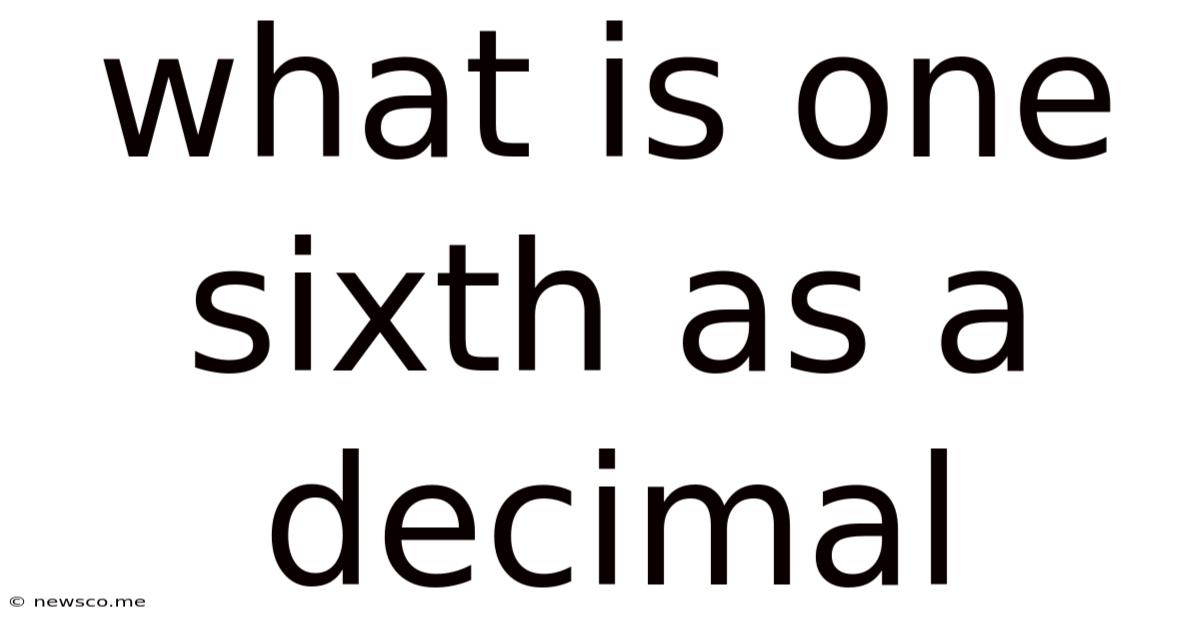What Is One Sixth As A Decimal
News Co
Mar 18, 2025 · 4 min read

Table of Contents
What is One Sixth as a Decimal? A Comprehensive Guide
Knowing how to convert fractions to decimals is a fundamental skill in mathematics, with applications spanning various fields. This comprehensive guide delves deep into the conversion of one-sixth (1/6) to its decimal equivalent, exploring the process, its practical uses, and related concepts. We'll not only provide the answer but also equip you with the understanding to tackle similar fraction-to-decimal conversions with confidence.
Understanding Fractions and Decimals
Before diving into the conversion, let's briefly review the basics of fractions and decimals.
Fractions: Represent parts of a whole. They consist of a numerator (the top number) and a denominator (the bottom number). The numerator indicates how many parts you have, and the denominator indicates how many equal parts the whole is divided into.
Decimals: Represent parts of a whole using a base-ten system. They are written with a decimal point, separating the whole number from the fractional part. Each place value to the right of the decimal point represents a decreasing power of ten (tenths, hundredths, thousandths, and so on).
Converting 1/6 to a Decimal: The Method
The most straightforward way to convert a fraction to a decimal is through division. We divide the numerator (1) by the denominator (6):
1 ÷ 6 = ?
Performing this division, we find that the result is not a terminating decimal. Instead, it's a repeating decimal. This means the decimal representation goes on forever, with a repeating pattern of digits.
Let's perform the long division:
0.1666...
6 | 1.0000
-6
40
-36
40
-36
40
-36
4...
As you can see, the remainder is always 4, leading to a continuous repetition of the digit '6'. This repeating decimal is represented as:
0.1666... or 0.16̅ (The bar over the 6 indicates that it repeats infinitely).
Understanding Repeating Decimals
Repeating decimals are a common outcome when converting fractions to decimals. They occur when the division process doesn't terminate, resulting in a sequence of digits that repeat indefinitely. These repeating decimals are rational numbers – they can be expressed as a fraction.
Non-Terminating vs. Terminating Decimals
- Terminating decimals: These decimals have a finite number of digits. For example, 1/4 = 0.25 is a terminating decimal.
- Non-terminating decimals: These decimals have an infinite number of digits. They can be either repeating (like 1/6) or non-repeating (like π, which is an irrational number).
Practical Applications of 1/6 as a Decimal
The decimal equivalent of 1/6 finds applications in various contexts:
- Engineering and Construction: Precise measurements often require converting fractions to decimals for accurate calculations.
- Finance: Calculating interest rates, discounts, or proportions often involves converting fractions to decimals.
- Data Analysis: Representing data in decimal form is often easier for computational analysis.
- Computer Programming: Many programming languages use decimal representation for numerical computations.
- Everyday Calculations: Dividing something into six equal parts necessitates understanding the decimal equivalent of 1/6.
Approximations and Rounding
Since 0.1666... is a repeating decimal, we often use approximations depending on the required level of precision. Common approximations include:
- 0.17: Rounding to two decimal places.
- 0.167: Rounding to three decimal places.
- 0.1667: Rounding to four decimal places.
The choice of approximation depends on the context. For most everyday calculations, rounding to two or three decimal places is sufficient. However, for applications requiring high precision, more decimal places might be necessary.
Other Fractions and Their Decimal Equivalents
Understanding the conversion of 1/6 helps us understand the conversion of other fractions. Here are some examples:
- 1/2 = 0.5 (Terminating decimal)
- 1/3 = 0.333... (Repeating decimal)
- 1/4 = 0.25 (Terminating decimal)
- 1/5 = 0.2 (Terminating decimal)
- 1/8 = 0.125 (Terminating decimal)
- 2/3 = 0.666... (Repeating decimal)
- 3/4 = 0.75 (Terminating decimal)
- 5/6 = 0.8333... (Repeating decimal)
Notice the pattern: fractions with denominators that are factors of powers of 10 (2, 5, 10, etc.) result in terminating decimals. Fractions with denominators that have prime factors other than 2 and 5 (like 3, 6, 7, etc.) result in repeating decimals.
Advanced Concepts: Continued Fractions
For a deeper understanding, the concept of continued fractions can be explored. Continued fractions provide an alternative way to represent rational numbers, offering insights into the nature of repeating decimals. They can be used to express a repeating decimal as a ratio of integers, confirming that repeating decimals are indeed rational numbers.
Conclusion: Mastering Fraction-to-Decimal Conversions
Converting fractions to decimals is a crucial skill in various aspects of life and different fields. Understanding the process, particularly for repeating decimals, is essential for accurate calculations and problem-solving. This guide has not only provided the decimal equivalent of 1/6 but also equipped you with the knowledge and understanding to tackle similar conversions confidently, helping you to master this fundamental mathematical skill. Remember to consider the required level of precision when using approximations and always strive for clear and accurate representation of numerical values in your work. This knowledge will enhance your problem-solving abilities and contribute to greater success in numerical endeavors.
Latest Posts
Related Post
Thank you for visiting our website which covers about What Is One Sixth As A Decimal . We hope the information provided has been useful to you. Feel free to contact us if you have any questions or need further assistance. See you next time and don't miss to bookmark.